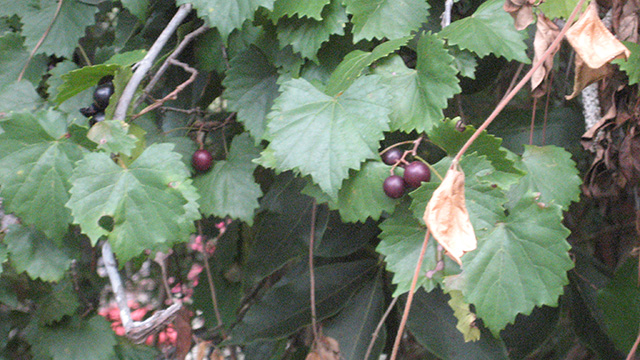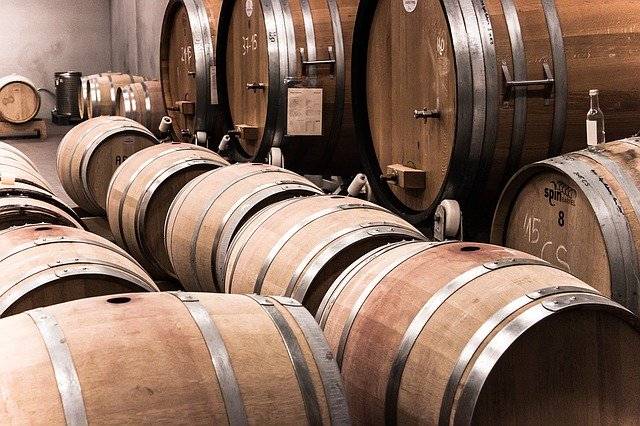Wild grapes make for fantastic wine, preserves, and snacks. So how do you find wild grapes? Here’s what to look for when you’re foraging for this delicious fruit.
Foraging for Wild Grapes
Wherever you live, there are most likely grapes that grow wild. Exactly when they are ready to pick will depend on your climate. If you live in the southern half of North America, now is the time to forage for wild grapes.
It would be obvious to say that one just needs to know where to look … but, honestly, it is more important to know to look! I grew up eating wild grapes and cultivated muscadines, but I’ve been quite surprised to learn that many others are ignorant or misinformed on the subject of grapes.
You May Also Enjoy:
“The Grapes of Youth: 11+ Age-Defying Reasons to Love This Plant”
A few years ago, while walking my dog, I spotted a neighbor laboring heavily in the hot, humid, late summer weather, removing the grapevines growing in his yard. I assumed he merely wanted to take out some ornamental hedges.
I casually commented that it was a shame to lose such a stand of tasty grapes. He looked at me in shock and sweaty exasperation and replied, “You can’t eat those! They could be poisonous!” “No,” I told him, “They are really good. You can eat them out of hand, make jelly, wine, or grape hull preserves. They are better than most grapes you buy at the store.” “But,” he protested, “how do you know they aren’t poisonous?” Well, that was a tough one to answer: “Because, they are grapes!”
‘Holy Cow, There Are Grapes Everywhere!’
How does one explain that a grape is a grape? Grapes are among the most delicious, widely cultivated and anciently utilized fruits in existence. It is very difficult to understand how humanity has reached a point in which the average person may not recognize one of the most ubiquitous and praised food plants in human history.
But, again today, as I was taking photos of wild vines, a man stopped to ask what I was doing. He owned the property next door and was friendly. I told him I was working on an article on foraging for wild grapes. “I didn’t know there were any grapes around here,” he said. “Where are they?” I pointed just over his head. Soon, he exclaimed, “Those are grapes? Holy cow, there are grapes everywhere!”
Indeed, there were.
One just needs to look for them. Amazingly, he had lived beneath wild grapevines for 20 years and had never seen them.
These were the grapes over his head—can you see them?
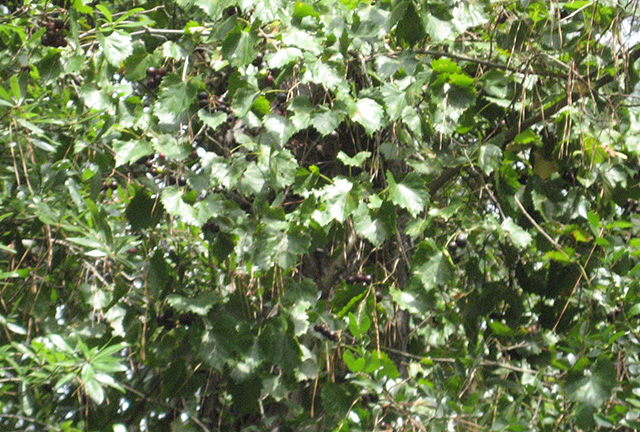
Granted, they are fairly small, and do not grow in the large clusters that European, vinifera grapes tend to form. But, wild grapes are still a nice-sized fruit.
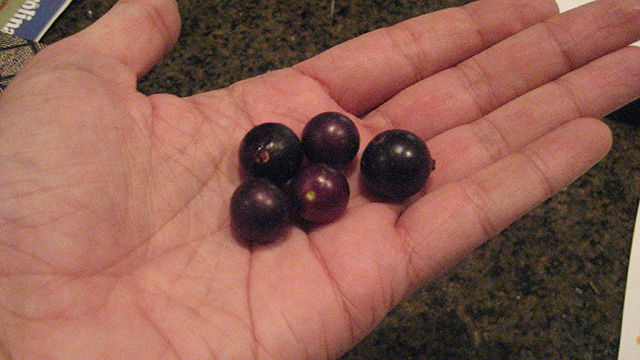
How to Find Wild Grapes
Grapevines generally grow in the understory, on the edge of wooded or thickety areas. So, when scouting for grapes, look up around 10 feet.
These were growing throughout a bamboo thicket, between 6 and 10 feet above the ground:
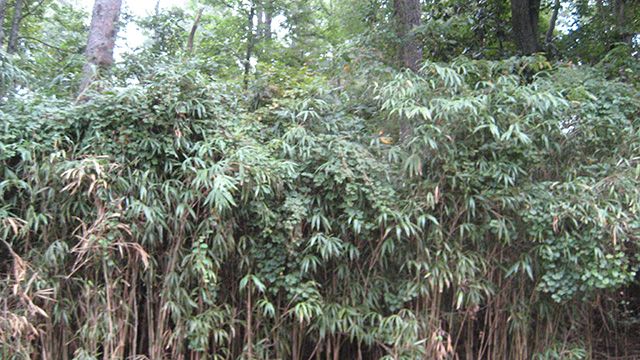
Others were as high as 20 feet up—these were in a hickory tree:
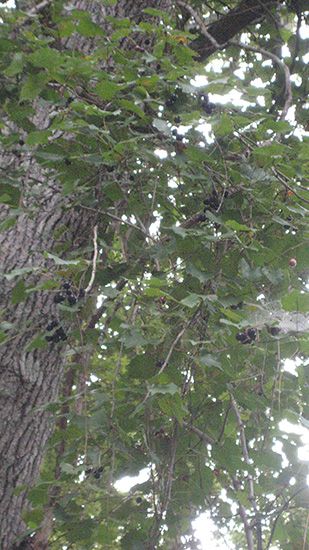
It would be worth using a ladder to pick these, as enough for a few gallons of wine could be gathered quickly. The grapevine is on the lower limbs, close to the trunk. The hickory nuts appear plentiful this year, as well, so I’ll be returning to these trees later this fall.
Be Sure to Look Down, Too!
Perhaps the surest way to find wild grapes that are growing above your normal field of vision is to look on the ground. Birds, raccoons, and opossums enjoy wild grapes, too, and can be messy eaters!
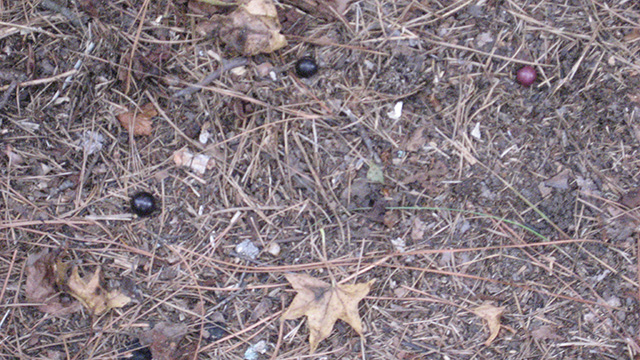
Another benefit of looking on the ground for grapes is spotting late summer mushrooms. I found this one a few days too late to harvest, but I’ll know where to look next time!
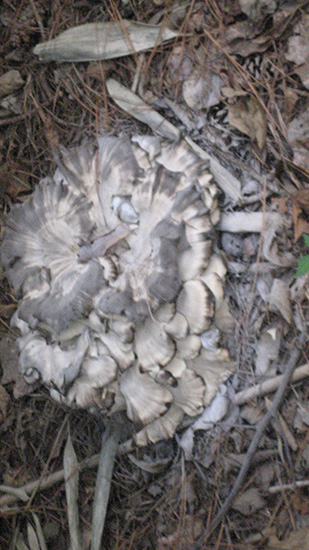
Poisonous Look-alike to Wild Grapes
The obvious question is, are there any poisonous look-alikes to wild grapes? Really, there is only one—and I’ve never seen it growing around here in the Carolinas. You will need to be able to identify Canada Moonseed if it grows where you live. The seed is a very distinct shape and quite different from grape seeds. Learn more here and here.
Historic Uses for Wild Grapes
The grapes I’m harvesting are a variety of muscadine. The muscadine has a long history in the Carolinas and Virginia. The “mother Vine” in Duplin County is believed to be the oldest cultivated grapevine in North America, perhaps dating to an expedition by Sir Walter Raleigh in 1584.1)https://northcarolinahistory.org/encyclopedia/mother-vine/
The muscadine and its lighter-skinned variant, the scuppernong, became big agricultural business in North Carolina following the Civil War. A small community called Vineland grew up around grape culture and shipped those grapes all over the nation via railcar. These grapes were used primarily to make wine. Prohibition and the Temperance movement put an end to this business, and the town no longer exists (it was absorbed into Whiteville, NC).
That our wild grapes were once so commonly used for wine makes it strange that so few people realize that you still can make excellent wine with wild grapes. Although I hesitate to mention his name, one of America’s leading writers and bloggers on foraging and wild foods stated flatly that it is impossible to make good wine with wild grapes.
I maintain that any fault lies with the winemaker and not the wine. I agree that many commercial muscadine wines are far too sweet. However, the winemaker can influence the wine tremendously by fermenting the juice on or off the grape skins, managing sweetness and acidity, the choice of yeasts, the temperature at which the wine is fermented, etc.
My grandfather made a wonderful, dry but slightly sweet, madeira-style wine from his muscadines—but table wines can be red or white, dry or sweet, or in between … very much to your taste.
You May Also Enjoy:
“Organic Wine That Actually Tastes GOOD!”
If this topic interests you, be sure to check out the book “Foundations of American Grape Culture”—published in 1909 by horticulturalist Thomas Volney Munson, DSc. In it, Munson lists dozens of varieties of American grapes and details their characteristics.2)Munson was responsible for producing hundreds of named cultivars in his experimental vineyards. His work is preserved by Denison County College in Denison, TX. Munson was a recognized viticulturist and winemaker who was honored by the French government for his work in developing wine grapes. He is even credited with saving European wine grapes when disease threatened. Vox Vineyards in Missouri produces award-winning wines based on the 27 or so varieties of native grapes pioneered by Munson—proving that it is, indeed, possible to make good wine from wild grapes.3)https://www.voxvineyards.com/our-story
Recipe: Grape Hull Preserves
Foraging for wild grapes is a great opportunity to get out in the woods. Learning about the grapes that grow in your area and how to best use them can be a great hobby. Here in the Carolinas, it is also a good time to scout for wild game, pick mushrooms, and look for medicinal herbs. Getting to know your micro-region and the plants that grow there is not only enlightening … it is delicious, as evidenced by this old family recipe!
Grape Hull Preserves
1 pound muscadine grapes
1 pound sugar
1 teaspoon lemon juice
Cut grapes in half and remove seeds.
Cook de-seeded grapes with sugar, stirring until hulls are tender (about 15 minutes). You can add a small amount of water if necessary.
Add lemon juice to taste.
Pack into hot jars and seal (or store in refrigerator).
Serve on hot, buttered, homemade biscuits and ENJOY!
What Do You Think?
If you forage for these sweet treats, how do you find wild grapes? What’s your favorite way to use them? Let me know in the comments below!
_________________
Psst! Our Lawyer Wants You to Read This Big, Bad Medical Disclaimer –> The contents of this article, made available via The Grow Network (TGN), are for informational purposes only and do not constitute medical advice; the content is not intended to be a substitute for professional medical advice, diagnosis, or treatment. Always seek the advice of a qualified health care provider with any questions you may have regarding a medical condition. If you think you may be suffering from any medical condition, you should seek immediate medical attention. You should never delay seeking medical advice, disregard medical advice, or discontinue medical treatment because of information provided by TGN. Reliance on any information provided by this article is solely at your own risk. And, of course, never eat a wild plant without first checking with a local expert.
The Grow Network is a participant in the Amazon Services LLC Associates Program, an affiliate program designed to provide a means for our team to earn fees for recommending our favorite products! We may earn a small commission, at no additional cost to you, should you purchase an item after clicking one of our links. Thanks for supporting TGN!

Judson Carroll grew up in both the mountains and coastal swamps of North Carolina, on family farms that predate Americas’ founding. Although he holds a Permaculture Design Certificate, most of what he knows about permaculture and gardening he learned from his grandfather and great grandfathers, who had a permaculture homestead and “food forest” before “permaculture” was a term. Judson learned to cook from his mother and grandmother, who were ladies best described as profound. He spends most of his life in the woods or on the water, and tries his best to be the kind of old fashioned, traditional, Southern gentleman who would make his ancestors proud.
References
| ↑1 | https://northcarolinahistory.org/encyclopedia/mother-vine/ |
|---|---|
| ↑2 | Munson was responsible for producing hundreds of named cultivars in his experimental vineyards. His work is preserved by Denison County College in Denison, TX. Munson was a recognized viticulturist and winemaker who was honored by the French government for his work in developing wine grapes. He is even credited with saving European wine grapes when disease threatened. |
| ↑3 | https://www.voxvineyards.com/our-story |
